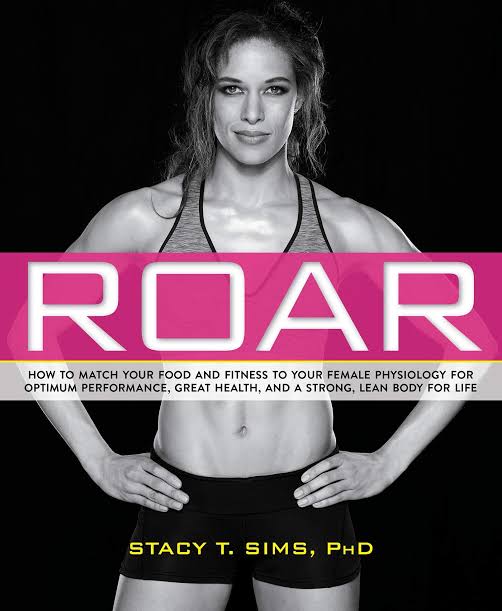EVERFIT book review : ROAR by Stacy Sims
Book Reviews, November 28, 2019
How to match your food and fitness to your female physiology for optimum performance, great health, and a strong, lean body for life. This is a great read even for the guys.
After meeting Stacy Sims and hearing her speak at a sports conference I was excited about getting into her book Roar. Although I don't personally subscribe with all of the recommendations due to my plantbased bias, her recommendations throughout the book were fantastic. They are backed up by research, and more importantly, years of working with top athletes with excellent results. Below are my notes from the book and how to practically apply the recommendations in regards to nutrition, periodisation, and training especially for women athletes.
Hormones
These are our bodies messengers. For a women the hormones revolve around the menstrual cycle which effects training, fueling, and ultimately performance. As a coach with around half of my athletes women this is an area I need to upskill. The major differences between the main male hormone - testosterone and the main female hormone Estrogen is testosterone leads to protein synthesis (larger muscles) and EPO release (more red blood cells - better O2 carrying capacity) while estrogen promotes fat deposition (lipoprotein lipase - enzyme, takes fatty acids from blood stream and stores in fat cells), inhibits muscle making ability, and makes more fat mass.
Menstrual cycle
Training sessions or racing will feel easier when you are in the low hormone phase of the cycle (day 1 - start of the period). There is a study of swimmers that show women swam their fastest times during their period and slowest during the days before the period started. Don't stress if your event falls during this time thou research shows the key performance measures like VO2 max and lactate threshold are constant throughout the cycle. With training it is HARDER to make and maintain muscle when these hormones are high.* Women need to put more carbs into the system during the premenstrual phase of the cycle - looking at a combination of 10-15g of protein and 40g of CHO before any workout longer than 90min (for example nut butter on wholegrain bread or soaked oats with blueberries and chia seeds) and around 40g of CHO (with a little protein and fat) per hour while you are out there.
*Why it's important for women to have protein that's high in leucine (muscle building amino acid) or BCAA - branched chain amino acids (leucine, isoleucine, and valine - 3 essential AA that make up 30% of your muscle tissue) I recommend AMAZONIA raw Protein Isolate with all of the BCAA present in 8.5g, 5.1g and 5.6g per 100g of leucine, isoleucine, and valine respectively.
Training tips to work in with the menstrual cycle
Day 1-5 Menstruation phase - LOW levels of estrogen and progesterone = possibly unmotivated to get moving BUT optimal time to build strength and muscle (if symptoms allow). If strong symptoms then look at restorative easy sessions.
Day 6-14 Follicular phase - End of period and about 3 days before ovulation - SURGE in estrogen and peak in testosterone = increased energy to workout & recover faster. Possible time to increase training intensity - if able LEAN IN to strength training + high intensity workouts.
Day 15-23 Ovulation phase - Estrogen briefly drops in concentration but progesterone rises. HIGHER levels of progesterone can contribute to muscle breakdown - making recovery more imperative. WARM DOWN well and gentle stretch after sessions + good protein intake. Also look at extra CHO during sessions as your body has more reliance on fat to fuel. Take extra days off during this phase for recovery if needed.
Day 24-28 Luteal phase - Estrogen and progesterone are at their PEAK, just before they fall and the start of the period. PMS and inflammation can impact motivation. Good time to REDUCE training load - technique workouts? Strength training - focus on form/technique. TRAIN TO DECREASE stress.
Menopause
Other ways to help is quality sleep. A common saying among athletes in "the race is won in bed". Sleep is a super performance agent (check out my article on the benefits of sleep and tips on improving your sleep environment - ) More than 60% of post menopausal women report problems with insomnia (National Sleep Foundation) This is related to the drop in progesterone (anti-anxiety hormone) which has direct sedentary effects. Estrogen increases REM sleep, assists serotonin metabolism, and helps with getting off to sleep quicker. Check out my article on sleep for more information https://everfit.co.nz/articles/wholistic-runner-part-2-sleep
Some other ways to help with sleep
- Tart cherry juice - high in sleep promoting chemical melatonin and has anti-inflamm properties. Drink chilled 30min before bed.
- Valerian root (tea or capsules) - In one study participants given 400mg of valerian extract reported better sleep compared to a placebo group.
- It's more difficult dealing with heat so pay more attention to cooling off post exercise, during session consume cool fluids.
- The body tries to get rid of heat by sending more blood to the skin instead of relying just on sweat so focus on hydration.
- There is less need for carbohydrates due to greater carb sensitivity. So aim for lower intake - 40-50g/hr
- Your body uses protein less effectively so type, quality, and when you eat the protein is very important. Soy protein doesn't contain enough leucine.
- Less power production so power and speed become important aspects of training for postmenopausal women.

.jpg?version=8)